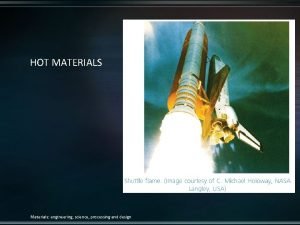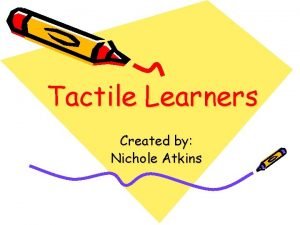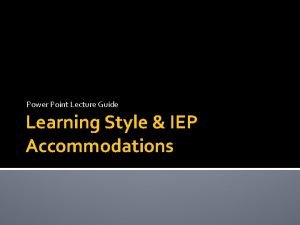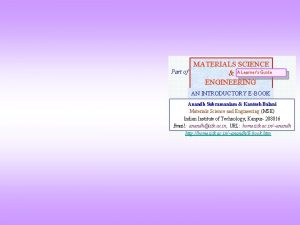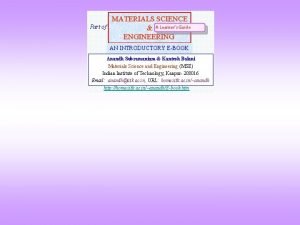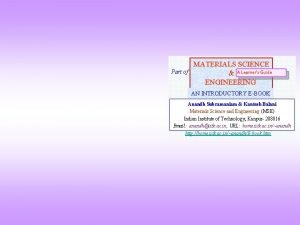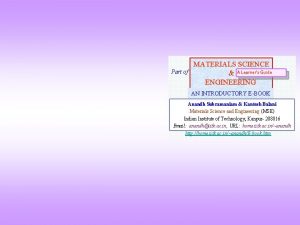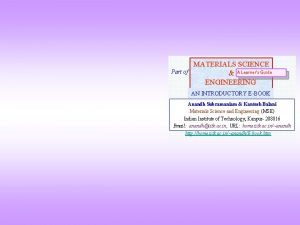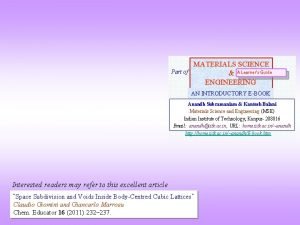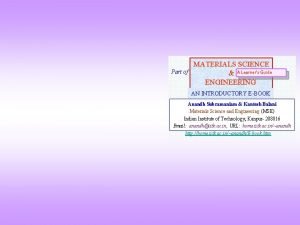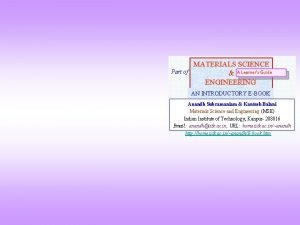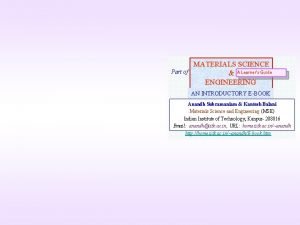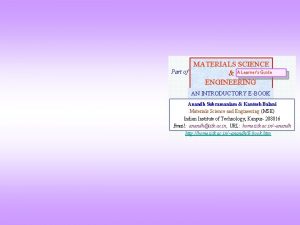Part of MATERIALS SCIENCE A Learners Guide ENGINEERING














- Slides: 14

Part of MATERIALS SCIENCE & A Learner’s Guide ENGINEERING AN INTRODUCTORY E-BOOK Anandh Subramaniam & Kantesh Balani Materials Science and Engineering (MSE) Indian Institute of Technology, Kanpur- 208016 Email: anandh@iitk. ac. in, URL: home. iitk. ac. in/~anandh http: //home. iitk. ac. in/~anandh/E-book. htm Caution Note: In any chapter, amongst the first few pages (say 5 pages) there will be some ‘big picture’ overview information. This may lead to ‘overloading’ and readers who find this ‘uncomfortable’ may skip particular slides in the first reading and come back to them later.

The Issue of Lengthscales q To understand structure sensitive properties (yield strength, fracture toughness etc. ) we may have to traverse across various lengthscales. q We have already seen in the Introduction chapter that we have to traverse across lengthscales to reach the scale of the component starting with the scale of the atoms (as repeated in the next slide). q When we traverse across lengthscales we get different perspectives of properties. Order, properties, etc. may seem very different at different lenghscales. q These aspects are considered by looking at some examples. Please also revise the issues related to global vs local

Travel across lengthscales to reach the scale of the component Thermo-mechanical Treatments Crystal Atom The ‘sub-atomic scale’ may also play a role in materials science (but we ignore it for now) Structure Electromagnetic Microstructure Phases • Casting • Metal Forming • Welding • Powder Processing • Machining Component + Defects & their distribution • Vacancies • Dislocations Residual • Twins + Stress • Stacking Faults • Grain Boundaries • Voids • Cracks Processing determines shape and microstructure of a component

Lengthscales in Materials Science Let us start with a cursory look at the lengthscales involved in Materials Science (we start with crystalline materials, though other forms may be equally important) Angstroms Dislocation Stress fields → Nanometers Microns Centimeters Unit Cell* Crystalline Defects Microstructure Component Grain Size *Simple Unit Cells Lattice spacing Pd nano-particle Si. O 2 particles Syringe dia. Human hair Micro-protrusions on a lotus leaf Gem Clip (Notes in the next slide)

q Unit cells of simple crystals are a few angstroms (though there might be crystals with large unit cells– examples of these may be found in Chapter 4) q Dislocations are crystalline 1 D defects (Chapter 5) with long range stress fields (i. e. they extend to the extent of the crystal). However, the ‘effective’ region of a dislocation stress field may be perceived to be a few tens of nanometers. q Grain size of typical materials is in the range of microns. However, materials may be produced with larger and much smaller (~ nm) grain sizes. q Components may be large (gas turbine blades) or small (cog wheel in a wrist watch). A representative size is a gear wheel in a cycle which is about 10 cm in diameter.

The next few slides takes the reader across multiple lengthscales- considering various properties Some of the terms and concepts introduced are very advanced for a beginner. The reader may take a cursory glance in the first instance and may return to these slides at a later stage in the course

1 Change of properties across lengthscales: polycrystalline copper (CCP structure) Atomic level (Å) → Unit Cell level (few Å-nm)→ Grain level (nm- m) → Material level (cm) q At the atomic level there is order only in the average sense (at T > 0 K) as the atoms are constantly vibrating about the mean lattice position. Hence, in a strict sense the perfect order is missing (a). The unit cell level is the level where the atomic arrangement becomes evident (crystal structure develops) and concepts like Burgers vector emerge, b. It is at this level that averaging with respect to probabilistic occupation of lattice positions in disordered alloys is made (say Ni 50 -Al 50 alloy is defined by a 50 -50 probability of Ni or Al occupying a lattice position). At the grain level (c, which is a single crystal), there is nearly perfect order (as the scale of atomic vibrations are too small compared to grain scale); except for the presence of defects like vacancies, dislocations etc. At this scale the material is also anisotropic (e. g. with respect to the elastic stiffness, which is represented by three independent numbers: E 11, E 12 & E 44). It is to be noted that the Cu crystal may be isotropic with respect to other properties. At the material level (d), assuming that the grains are randomly oriented, there is an averaging of the elastic modulii and the material becomes isotropic. At this scale, the crystalline order which was developed at the grain level (c) is destroyed at the grain boundaries and there is no long range order across the sample. When the material is rolled or extruded, it will develop a texture (preferred directional properties), which arises due to partial reorientation of the grains. That is, we have recovered some of the inherent anisotropy at the grain scale. As we can see, concepts often get 'inverted' as we go from one lengthscale to another. Traversing four lengthscales in a Cu polycrystal: schematic of the changing order and properties. a) instantaneous snapshot of a vibrating atom, b) crystalline order (unit cell), c), grain level (single crystal- anisotropy) , d) the material level (isotropy due to randomly oriented grains). Continued…

Atomic Level q Atoms are constantly vibrating (at T > 0 K). q Order only in the average sense. q Hence, the ‘perfect’ order is missing. Unit Cell q The unit cell level (multiple unit cells) is the level where the atomic arrangement becomes evident (crystal structure develops) and concepts like Burgers vector emerge. Microstructure q Nearly perfect order (scale of atomic vibrations are too small). q Presence of defects like vacancies, dislocations etc. q Material is anisotropic (e. g. with respect to the elastic stiffness, which is represented by three independent modulii: E 11, E 12 & E 44) q Crystal may be isotropic with respect to other properties. Bulk Structure q Assuming that the grains are randomly oriented. q Averaging of the elastic modulii and the material properties are isotropic.

2 Change of properties across lengthscales: Fe sample which has not been magnetized Sub-atomic scale (< Å) → Crystal (band) level (Å) → Domain level (~few m) → Material level (cm) q Consider a magnetic material (E. g. Fe, Ni) below the Curie temperature (but T > 0 K), where it is ferromagnetic in nature (i. e. there is a spontaneous tendency for magnetic moments to align in parallel configuration). q At the sub-atomic level the magnetic moments arise from electron spins and orbital motion a total possible magnetic moment of 6 B if all the magnetic moments align. q At the lengthscale of the formation of bands due to crystalline order, only 2. 2 B survives (i. e. most of the orbital magnetic moment is ‘quenched’). In this condition the atomic magnetic moments try to align, but thermal effects lead to partial disordering leading to further loss in net ‘magnetization’. q The parallel alignment of ‘spins’ occur within regions in the sample called domains, which are typically of micrometer size. The configuration of the domains is in such manner so as to reduce the magnetostatic energy. This arrangement of domains, wherein they are not preferentially aligned, leads to no net magnetization of the sample (in a non-magnetized sample). q Hence the story as we traverse lengthscales is: Sub-atomic origins of magnetic moments (most moments are cancelled by pairing and only 6 B survives) Crystal Band level (most of the orbital magnetic moments are quenched in and only 2. 2 B survives) Thermal disordering leads to further loss in magnetization (domain) (say if n atoms are there, then the net magnetic moment within a domain n matomic; turns out to be less than n matomic) No net magnetization at the sample level (domain configuration leads to minimization of external magnetic fields).

Going from an atom to a component: Fe to Gear Wheel q In this example there will be a synthesis of concepts which have been presented before. It will also become amply clear as to how different lengthscales 'talk' to each other to determine a property. Let the component be a gear wheel, which requires good surface hardness and abrasion resistance; along with good toughness (for shock resistance). For simplicity assume that it is made of plain carbon steel (alloy of Fe and 0. 1 -2. 0 %C). The Fe atom has a propensity for metallic bonding which ensures good ductility, thermal conductivity etc. ; but, is soft compared to (say) a covalently bonded material (e. g. diamond). This 'softness' is also directly related to the metallic bond, which leads to a low Peierls stress. This ductility further helps in improving the microstructural level properties like tolerance to cracks (high fracture toughness). Sharp crack tips (e. g. in window pane glass), lead to high stress amplification (high stress intensity factor), which results in much lower stresses for causing fracture. But, when a crack tip gets blunted due to plastic deformation, it reduces the stress amplification and enhances the toughness of the material. The ease of deformation and good tolerance to cracks implies good ductility in a material. This available ductility is useful in the deep drawing/forming of the component (such as making long-form containers). q Pure Fe at room temperature has a BCC lattice; which implies that it has a higher Peierls stress (harder/stronger) as compared if it were FCC Fe (which will happen if you heat Fe beyond ~910 C). This happens because Peierls stress is a strong function of the Burgers vector, which is determined by the crystal structure. Hence, there are two sides to the Peierls stress: one coming due to bonding characteristics and the other from the crystal structure. In the Fe-C alloy, C sits in the interstitial position (the octahedral void in BCC Fe) and gives rise to solid solution hardening. The slowly cooled alloy has a mixture of (BCC solid solution) and Fe 3 C (a hard phase) phases; which makes the microstructure harder than that of a single phase alloy. The surface of the gear wheel is carburized (Figure , i. e. increased carbon concentration at surface) and the wheel is quenched to produce a different phase of the Fe-C alloy: the Martensitic phase. Martensite is hard (but brittle) and provides the requisite surface hardness to the wheel; while the interior continues to be tough. This would constitute an early example of a functionally graded material. q At the component level, the similar concepts of toughening (via design features) should be incorporated, like there should be no sharp corners in the component (similar to cracks). Sharp corners will act like stress concentrators, which will become zones where cracks will initiate (at micron-scale) and might rapidly propagate to result fracture of bulk component. The Gear wheel

Multi-scale materials q In many ‘structures’ found in nature, a multi-scale strategy is at the heart of the properties observed. The superhydrophobicity observed on a lotus leaf surface arises not only from the inherent hydrophobic (waxy) coating on the surface, but also from an architecture involving roughness at many lengthscales. The enhanced impact toughness of an abalone shell comes from a ‘lengthscale dependent design’, utilizing scale dependent strength of materials. q Gecko: properties arising from a hierarchy of structures Gecko is known for its super sticky feet, as it can stick even to a glass surface (works on almost any surface!). In spite of the strong adhesion provided by the gecko's feet the animal can move around with ease (i. e. de-adhesion is carried out with considerable ease). Gecko's foot contains rows of setae (~106 setae on each foot, ~ 5 m diameter), each of which is tipped with few hundred fine hair-like structures called spatulae. These fine spatulae increase the surface area of contact and the adhesion is through van der Waal's forces. The setae can be detached by increasing the angle it makes to the surface and low forces are required for this process. It spite of having this 'sticky' property gecko feet are self cleaning (clean within a few steps) and don't stick to each other!

q Lotus Leaf: Water does not stick to the surface of lotus leaf (small droplets 'bead up') and cleans the surface-dirt as it rolls off. Microscopically, the lotus leaf surface has fine distribution of micro-protrusions (~ 10 µm long, ~ 10 µm high and spread ~ 15 µm apart), which enhance the surface roughness and increase contact area by a few orders of magnitude. Further, these micro-protrusion and the base surface have nano-hairs (~ 80 -150 nm diameter) spread over the entire surface of Lotus leaf, making the surface superhydrophobic. It is to be noted that the wetting angle (purely arising from the chemical nature of the surface and as characterized by the surface energy) can reach a maximum of 120. Contact angles >165 are observed on a lotus leaf and this increase of 45 arises from the hierarchical structure of the lotus leaf (i. e. from micro-protrusions and nanohairs on the surface of a lotus leaf). For comparison Lotus leaf- a hierarchical structure Water on lower side of banana leaf Water on lotus leaf Protrusions Hairs on the base Hairs on protrusion

q Nacre: The sea-shell (or nacre) has tablets or plies of calcium carbonate sandwiched by a very fine protein layer. This protein layer acts as glue to hold the layers (similar to cement) in a brick-cement structure. Correspondingly, the fracture toughness of the nacre exceeds 1000 times the toughness of calcium carbonate (a very brittle material). Hence rearrangement and gluing by protein nano-layer can drastically enhance the fracture toughness while retaining its hardness. Two layers seen in cross -section SEM Abalone shell Zoom-in The design starts with the shape of the shell Nano-bricks

Funda Check q q q How can we understand the uniaxial tension test, by looking across lengthscales? We will learn about the details of the uniaxial tension test (UTT) in the chapter on plasticity To understand the simple UTT, we have to travel across lengthscales ~Å to ~cm. Young’s modulus involves bond stretching (distortion) atomic dimensions ~5 Å. Yield point (as in steel) involves dislocations (stress fields) and carbon atoms ~10 nm. Yield stress involves motion of dislocations and hindrance by grain boundaries ~10 m. Drop in stress due to necking sample length scale ~1 cm. Yield stress dislocations and grain boundaries involved ~ 10 Strain hardening dislocation interactions involved ~10 Necking sample lengthscale ~cm Yield point phenomenon scale involving dislocations and carbon atoms ~10 nm Young’s modulus bond stretching atomic dimensions Al Steel
 Principle of remedial teaching
Principle of remedial teaching Hot materials
Hot materials Iit delhi material science
Iit delhi material science My subject is
My subject is Natural materials and man made materials
Natural materials and man made materials Household material useful and harmful
Household material useful and harmful Natural man made
Natural man made Adapting and adopting materials
Adapting and adopting materials Direct materials budget with multiple materials
Direct materials budget with multiple materials Global vs analytical learners
Global vs analytical learners What is grammar
What is grammar Tactile learner definition
Tactile learner definition Global vs analytical learners
Global vs analytical learners Auditory learning characteristics
Auditory learning characteristics Eager and lazy learning
Eager and lazy learning

